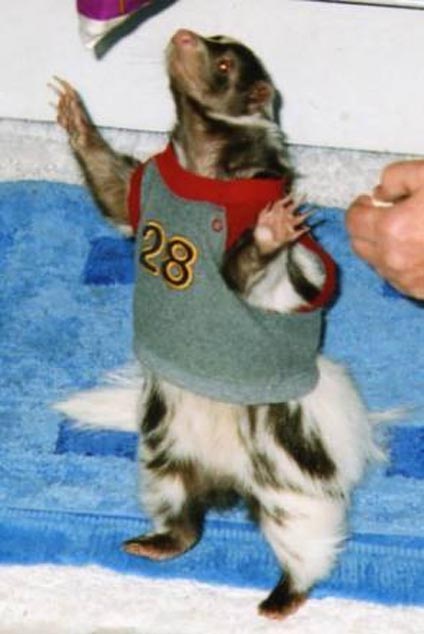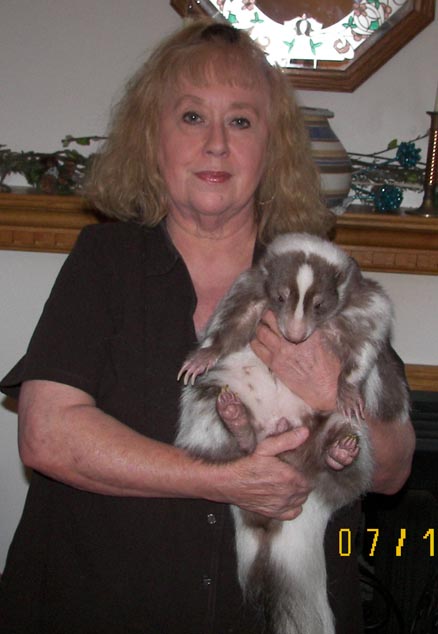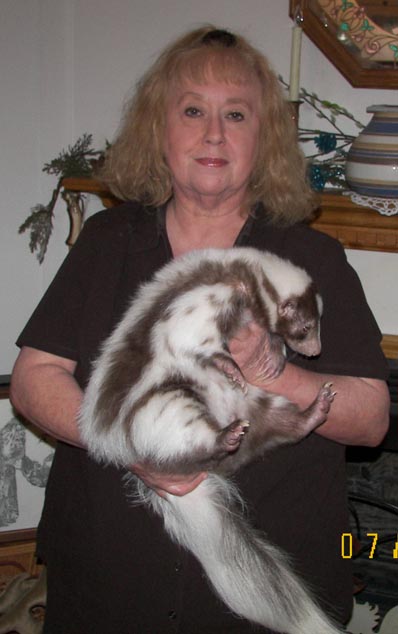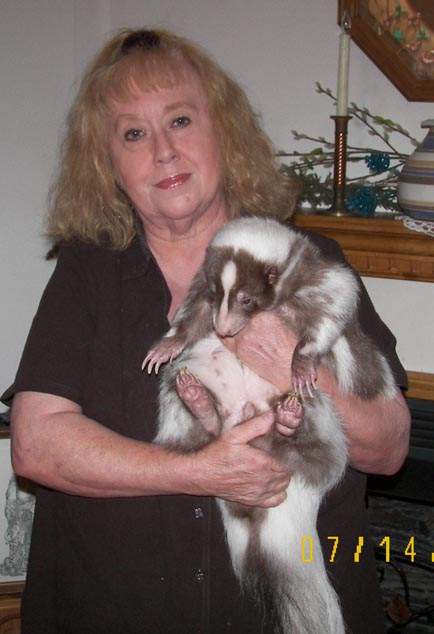Happy New Years Message From Dillan

Kermit the Frog once said:
“It’s not easy being green”
In that respect, I can relate to him in a very similar way:
“It’s not easy being a skunk”
First impression are usually lasting ones, and skunks very often are perceived in that context. But what if we were to look at the skunk in a new way?
Let’s take a walk in a dark forest and find out everything you ever wanted to know about the skunk, but were afraid to take a good whiff to find out:
(1) Everyone assumes that if a skunk sees them that he will immediately spray them with its musk. In reality, skunks are gentle creatures by nature, and have a “live and let live” attitude. You have to really frighten or threaten a skunk to cause it to use its odorous defense. Skunks really don’t like the smell either and it is only used as a last resort.
Skunks that feel threatened will stamp their front feet, make a false charge, turn their bodies into a U shape and walk sideways with tails erect. If the danger diminishes, they lower their tails and go about their outing.
Skunks are very near sighted and will sometimes proceed to walk up to people or other animals. This does not indicate aggression, but that they likely were unaware of the person or animal. Skunks rely solely on their sense of smell and acute hearing.
(2) All skunks have rabies! This is untrue. Skunks are clean, healthy animals. They do not harbor the rabies virus. Skunks that live in a rabies free area are not infected with rabies. Skunks do not pose any more of a rabies threat than unvaccinated dogs or cats.
The real danger to skunks, other animals and humans is if an area experiences a rabies outbreak from a rabid animal visiting in that area. In a rabies infected area, more skunks will become infected, than other wildlife. The reason skunks are at greater risk is because of their demeanor not to run from an attacker, but to stand their ground and spray. This allows skunks to be open to bites from an animal infected with rabies.
Luckily, the skunks bold nature and vivid white stripes are nature’s stop sign to other animals to stop! stay back! this animal is different. Unfortunately, domestic dogs have forgotten what their distant relatives the wolf, have learned about skunks. Dogs repeatedly will go after skunks, and repeatedly get sprayed…
Oh yes, there is a misconception that a skunk seen out in the day time is either rabid or sick. In most cases this is false. Often times a skunk has been displaced by the day time coming and goings of humans. Think about it! How would you like trying to sleep after a night of making a living for yourself, only to be disturbed by still more housing construction into your shrinking environment?
(3) Skunks are actually very good for our environment. Because skunks choose to live among and near humans they very often come into conflict with people. Actually having a skunk living near you is not a bad thing. Skunks eat 70% of all harmful insects known to man, including beetles, grubs, termites, and even poisonous spiders. They also are incredible mousers, and will also eat snakes.
Humans and skunks can co exist very well together. One only has to become aware and accustom to the other. Simple rules of engagement are to keep your dogs and cats inside after dark or take them out on a leash. You should use a flashlight so not to walk up and startle a skunk. Skunks are on a mission of foraging and seldom take notice of an approaching person or other animal.
Skunks are very important to all of our well being. The very first legislation was enacted in the late 1800’s to protect the skunk. This came out of the concern from Illinois Hop Growers. If not for the skunk, at that time the entire Hop crop would have been lost to the Hop Beetle. Hops are the main ingredient in the making of beer.
Skunks are one of the few animals that can detect insects and larva in the ground and on the vine. Sure we get over zealous on your golf courses and in your gardens, but with us around you don’t have many harmful insects, or the need for costly and dangerous insecticides.
Remember, if it were not for skunks, Super Bowl Parties, with beer flowing might never be the same again.
(4) Did you know that there are domesticated skunks? Early pilgrims coming to this new land discovered that Native Americans had domesticated a lineage of skunks that were used as mousers to keep rodents out of their food stores and in their Tepees and Huts. The tame skunks were cherished by the Native children as pets.
It was the Native Americans that perfected the method of descenting skunks (removal of the skunk’s scent glands) that is still in use today. The Native American culture has designated many animals as “Spirit Guides”. These selected animals were revered for their special powers. The skunk stands out for his ability as an animal who teaches respect, patience, and tolerance. The skunk is recognized for the ability to persevere in the face of the many wrongs bestowed upon him. Strong warriors riding into battle wore skunk fur ankle bracelets; this warned others that this strong, brave warrior, like the skunk would back down from no one.
So revered was the skunk that a sacred hill in Wisconsin, Skunk Hill, is still used as a place for Native Americans to perform their rituals, and dream dances. Also named for the skunk is the mighty Skunk River, in Iowa, and the city of Chicago, Illinois, which is an interpretation of the Powtawatomi word “Checagou.” for wild onion, skunk cabbage and skunk.
The history of the Domestic skunk continues with two hundred plus years in which many were held on fur farms to fill the demand for fur garments. Skunk fur was considered the second most valuable fur, muskrat being the first and the mink being the third. Skunk fur has a rich pelage and wears very well. Skunk fur was marketed under the label of sable or black marten. The journey of the skunk into domestication eventually took a new direction after the wearing of natural fur fell out of favor. Fur farms began raising skunks for pets. In the 1940,s you could order a domestic skunk for a pet from the Sears & Roebuck Catalog.
Today the domestic skunk is thought to live as a companion animal in over a million homes in the United States as well as being exported to Great Britain, Japan, Holland, Germany, and Italy as pets. Skunks are native only to North America, ranging from Mexico, throughout the United States and into Canada. Skunks once only black and white in color have mutated in captivity to colors ranging from shades of chocolates, smokes, champagnes, and rare lilacs.
So there is a lot more to the story of the skunk than a misunderstood reputation and a foul smell. Perhaps it is the legacy of what are untruths, laced with ignorance and the inability to open ones mind to the value and beauty of the skunks that really stinks.
For Chilin’ With Dillan,
Dillan Hildebrand.
Contact Dillan at chillanwithdillan@yahoo.com



